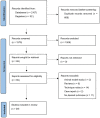Biomechanical outcomes of superior capsular reconstruction for irreparable rotator cuff tears by different graft materials-a systematic review and meta-analysis
- PMID: 36700024
- PMCID: PMC9869421
- DOI: 10.3389/fsurg.2022.939096
Biomechanical outcomes of superior capsular reconstruction for irreparable rotator cuff tears by different graft materials-a systematic review and meta-analysis
Erratum in
-
Corrigendum: Biomechanical outcomes of superior capsular reconstruction for irreparable rotator cuff tears by different graft materials-a systematic review and meta-analysis.Front Surg. 2023 May 22;10:1173516. doi: 10.3389/fsurg.2023.1173516. eCollection 2023. Front Surg. 2023. PMID: 37284557 Free PMC article.
Abstract
Background: Irreparable rotator cuff tears (IRCT) are defined as defects that cannot be repaired due to tendon retraction, fat infiltration, or muscle atrophy. One surgical remedy for IRCT is superior capsular reconstruction (SCR), which fixes graft materials between the larger tuberosity and the superior glenoid.
Patients and methods: The Preferred Reporting Items for Systematic Reviews and Meta-Analysis (PRISMA) criteria were followed for conducting the systematic review and meta-analysis. From their inception until February 25, 2022, Pubmed, Embase, and Cochrane Library's electronic databases were searched. Studies using cadavers on SCR for IRCT were also included. The humeral head's superior translation and subacromial peak contact pressure were the primary outcomes. The humeral head's anteroposterior translation, the kind of graft material used, its size, and the deltoid load were the secondary outcomes.
Results: After eliminating duplicates from the search results, 1,443 unique articles remained, and 20 papers were finally included in the quantitative research. In 14 investigations, the enhanced superior translation of the humeral head was documented in IRCTs. In 13 studies, a considerable improvement following SCR was found, especially when using fascia lata (FL), which could achieve more translation restraints than human dermal allograft (HDA) and long head of bicep tendon (LHBT). Six investigations reported a subacromial peak contact pressure increase in IRCTs, which could be rectified by SCR, and these studies found a substantial increase in this pressure. The results of the reduction in subacromial peak contact pressure remained consistent regardless of the graft material utilized for SCR. While there was a statistically significant difference in the change of graft material length between FL and HDA, the change in graft material thickness between FL and HDA was not significant. The humeral head's anterior-posterior translation was rising in IRCTs and could be returned to its original state with SCR. In five investigations, IRCTs caused a significant increase in deltoid force. Furthermore, only one study showed that SCR significantly decreased deltoid force.
Conclusion: With IRCT, SCR might significantly decrease the glenohumeral joint's superior and anterior-posterior stability. Despite the risks for donor-site morbidity and the longer recovery time, FL is still the best current option for SCR.
Keywords: biomechanics; graft; material; rotator cuff; superior capsular reconstruction.
© 2023 Zhao, Jia, Wen and Zhang.
Conflict of interest statement
The authors declare that the research was conducted in the absence of any commercial or financial relationships that could be construed as a potential conflict of interest.
Figures
















Similar articles
-
Superior Capsular Reconstruction Provides Sufficient Biomechanical Outcomes for Massive, Irreparable Rotator Cuff Tears: A Systematic Review.Arthroscopy. 2021 Jan;37(1):402-410. doi: 10.1016/j.arthro.2020.09.007. Epub 2020 Sep 18. Arthroscopy. 2021. PMID: 32950647
-
Superior capsule reconstruction using 8mm-thick fresh-frozen fascia lata graft for irreparable supraspinatus and infraspinatus tendon tears: A cadaveric biomechanical study.J Orthop Sci. 2025 Mar 12:S0949-2658(25)00072-7. doi: 10.1016/j.jos.2025.02.007. Online ahead of print. J Orthop Sci. 2025. PMID: 40082143
-
Superior capsular reconstruction for irreparable supraspinatus tendon tears using the long head of biceps: A biomechanical study on cadavers.Orthop Traumatol Surg Res. 2019 Apr;105(2):257-263. doi: 10.1016/j.otsr.2018.10.023. Epub 2019 Feb 21. Orthop Traumatol Surg Res. 2019. PMID: 30799174
-
Editorial Commentary: Superior Capsule Reconstruction: Acellular Allograft at 45° of Glenohumeral Abduction Improves Glenohumeral Stability, but Fascia Lata Autograft Remains Superior.Arthroscopy. 2023 Apr;39(4):931-934. doi: 10.1016/j.arthro.2022.12.020. Arthroscopy. 2023. PMID: 36872033
-
Superior capsule reconstruction for irreparable rotator cuff tears: a systematic review of biomechanical and clinical outcomes by graft type.J Shoulder Elbow Surg. 2020 Feb;29(2):392-401. doi: 10.1016/j.jse.2019.07.005. Epub 2019 Sep 12. J Shoulder Elbow Surg. 2020. PMID: 31522915
Cited by
-
Superior Capsular Reconstruction Combined With Latissimus Dorsi Transfer for Massive Irreparable Rotator Cuff Tears With Shoulder Hyperlaxity.Arthrosc Tech. 2025 Jun 3;14(7):103620. doi: 10.1016/j.eats.2025.103620. eCollection 2025 Jul. Arthrosc Tech. 2025. PMID: 40822215 Free PMC article.
-
Evaluating tendon transfers in irreparable rotator cuff tears: A systematic review of clinical outcomes and failure rates.Shoulder Elbow. 2025 Aug 14:17585732251368884. doi: 10.1177/17585732251368884. Online ahead of print. Shoulder Elbow. 2025. PMID: 40821879 Free PMC article.
-
Surgical Management of Massive Irreparable Cuff Tears: Superior Capsule Reconstruction and Rotator Cable Reconstruction.Curr Rev Musculoskelet Med. 2024 Apr;17(4):101-109. doi: 10.1007/s12178-024-09887-x. Epub 2024 Feb 10. Curr Rev Musculoskelet Med. 2024. PMID: 38340293 Free PMC article. Review.
References
-
- Pashuck TD, Hirahara AM, Cook JL, Cook CR, Andersen WJ, Smith MJ. Superior capsular reconstruction using dermal allograft is a safe and effective treatment for massive irreparable rotator cuff tears: 2-year clinical outcomes. Arthrosc. (2021) 37(2):489–96 e1. 10.1016/j.arthro.2020.10.014 - DOI - PubMed
-
- Kovacevic D, Suriani RJ Jr., Grawe BM, Yian EH, Gilotra MN, Hasan SA, et al. Management of irreparable massive rotator cuff tears: a systematic review and meta-analysis of patient-reported outcomes, reoperation rates, and treatment response. J Shoulder Elbow Surg. (2020) 29(12):2459–75. 10.1016/j.jse.2020.07.030 - DOI - PMC - PubMed
Publication types
LinkOut - more resources
Full Text Sources

